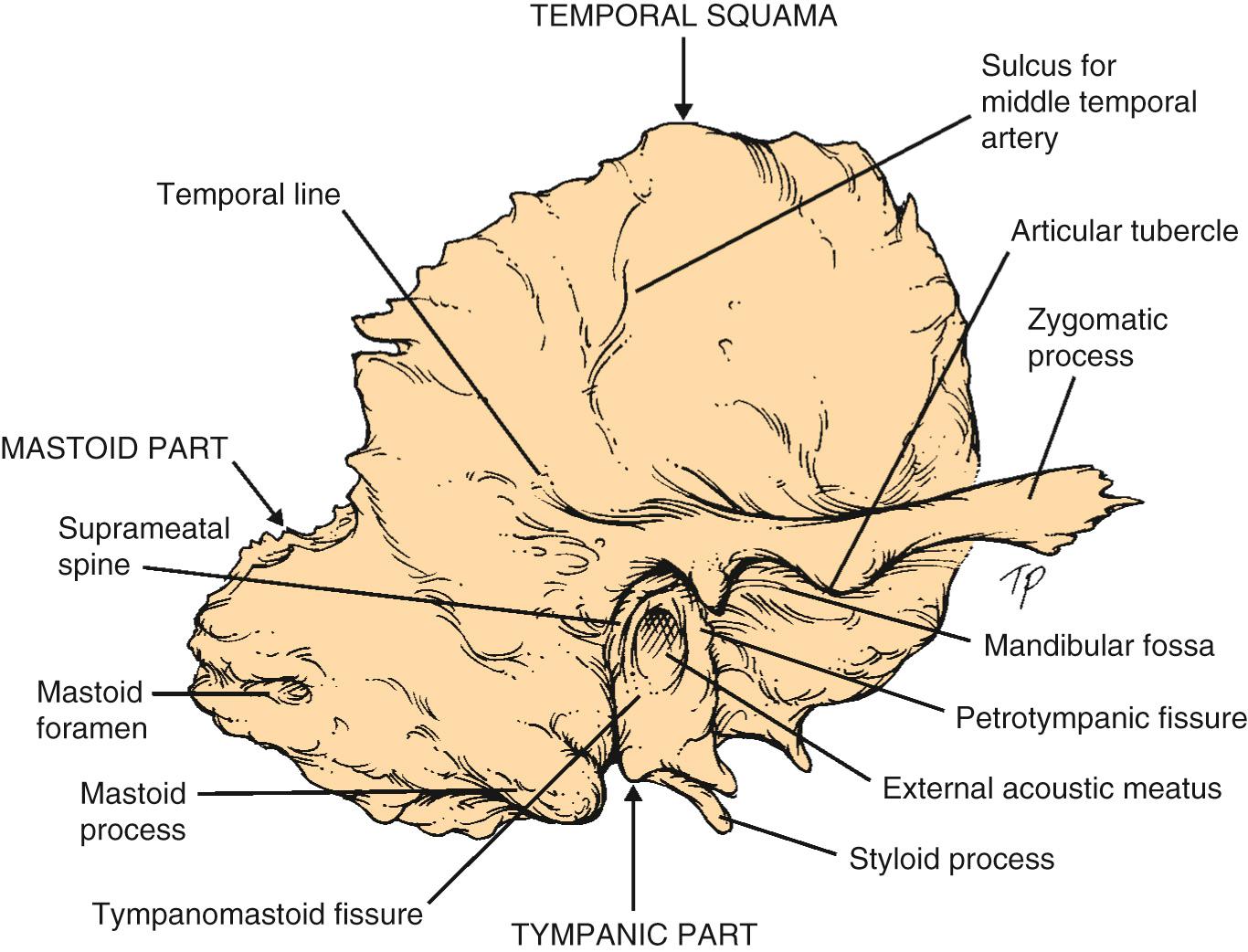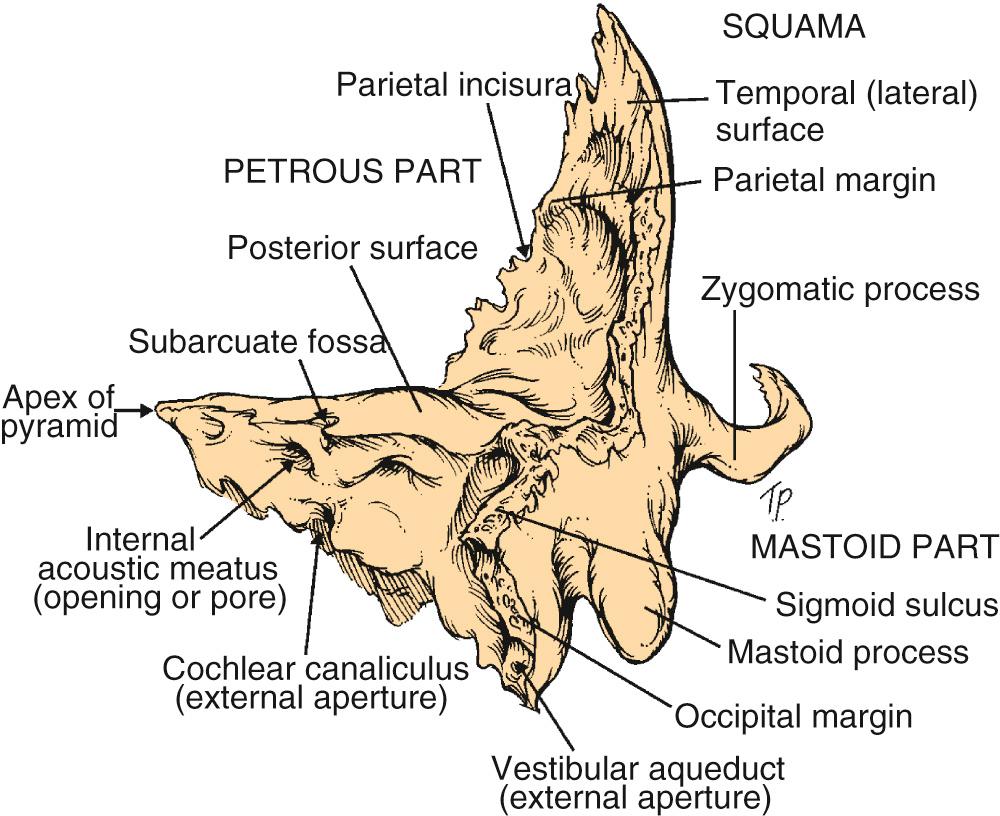Physical Address
304 North Cardinal St.
Dorchester Center, MA 02124
Although all major components of the temporal bone are present in infants, the mastoid tip has yet to develop. The stylomastoid foramen is located more superficially, which makes the facial nerve vulnerable to surgical trauma.
The temporal line approximates the level of the middle cranial fossa dural plate. The position of the tegmen and the degree of mastoid pneumatization can vary.
An important landmark when one is performing mastoid surgery is the antrum. The antrum can easily be identified in a well-saucerized cavity by skeletonizing the tegmen plate and properly thinning the external auditory canal wall.
Failure to identify the superior limit of the mastoid dissection (tegmen plate) could result in looking for the antrum too inferiorly and result in injury to horizontal semicircular canal.
The most important landmarks for identifying the mastoid segment of the facial nerve are the horizontal semicircular canal, the short process of the incus, and the posterior bony external auditory canal. The digastric ridge can be traced anteromedially to find the stylomastoid foramen.
An intact canal wall mastoidectomy obviates long-term postoperative concerns of a mastoid cavity, such as infection and the requirement for periodic cleaning.
Identification of the facial nerve is key to a canal wall–down procedure (appropriate lowering of the posterior canal wall) and the intact canal wall approach (opening the facial recess).
The incidence of recidivistic (residual or recurrent) cholesteatoma is higher in intact canal wall versus canal wall–down mastoid procedures.
Canal reconstruction techniques combine the benefits of intact canal wall mastoidectomy with the improved exposure of the canal wall–down procedure. Cholesteatoma recidivism rates approximate those of the intact canal wall technique.
Dehiscence of the facial nerve is approximately 20% in cholesteatoma cases, with the most common area being in the tympanic segment overlying the oval window.
When applied in properly selected cases, techniques such as mastoid obliteration, canal reconstruction, otoendoscopy, and retrograde mastoidectomy may spare patients significant discomfort during chronic ear surveillance; it can also decrease morbidity during second-look procedures and, in some cases, may obviate the need for additional surgery.
This chapter focuses on mastoid surgery as it relates to chronic ear disease. Mastoidectomy and related techniques also have broad application in the treatment of several otovestibular disorders. These are covered in detail in subsequent chapters. Box 143.1 outlines various indications to which mastoidectomy technique may be applied.
Chronic otitis media
Cholesteatoma
Acute suppurative mastoiditis and related complications
Facial nerve palsy (idiopathic vs traumatic)
Menière disease (endolymphatic sac decompression)
Benign paroxysmal positional vertigo (posterior canal occlusion, singular neurectomy)
Superior canal dehiscence syndrome (transmastoid technique)
Refractory vestibulopathy (vestibular nerve section)
Cerebellopontine angle tumors
Petrous apex cholesterol granuloma (retro-/infra-labyrinthine approach)
Spontaneous cerebrospinal fluid leak
Encephalocele
Cochlear implantation
Auditory brain stem implant (translabyrinthine approach)
Temporal bone/parotid malignancy (temporal bone resection)
The first scholarly treatise on mastoid surgery for suppurative disease was written by Schwartze in 1873. This described a cortical mastoidectomy with limited air cell exenteration. For acute and coalescent mastoiditis, both prevalent in the preantibiotic era, this procedure proved remarkably efficacious but rarely curative for the causative disease. In 1890, Zaufa described removing the superior and posterior canal wall, tympanic membrane, and lateral ossicular chain—a procedure now known as the radical mastoidectomy. It was modified by Bondy, who recognized that disease limited to the pars flaccida could simply be exteriorized, leaving the uninvolved middle ear alone. His description of the modified radical mastoidectomy or Bondy procedure in 1910 represented one of the first reports to address hearing function. Interest in hearing preservation and restoration gained further attention after Lempert introduced the fenestration operation in 1938 and Zollner and Wullstein described tympanoplasty techniques in the early 1950s. During the next decade, Jansen and Sheehy and Patterson extended these principles of restoring function and maintaining normal anatomy with the introduction of the intact canal wall mastoidectomy.
As reviewed in Chapter 126 , the temporal bone is composed of squamous, tympanic, mastoid, and petrous regions ( Figs. 143.1 and 143.2 ). This chapter focuses primarily on the mastoid portion, which articulates with the parietal and occipital bones. It typically houses the mastoid air cell system, which is in continuity with all other pneumatized portions of the petrous pyramid. Other important structures housed within the mastoid include the facial nerve, jugular bulb, and labyrinth. There are a few important surface landmarks on the mastoid. The temporal line, which extends posteriorly from the zygomatic root, helps denote the approximate location of the middle fossa's floor. The suprameatal spine, or spine of Henle, is a small bony protuberance that extends superficially from the posterior and superior bony external auditory canal (EAC). Just posterior to this spine is a cribriform area, which approximates the location of the underlying mastoid antrum.


All major components of the temporal bone are present in infants, but one notable difference has surgical implications. In infants, the mastoid tip has yet to develop, and the stylomastoid foramen is located more superficially, which makes the facial nerve vulnerable to surgical trauma.
The nomenclature for mastoid surgery is often confusing and may describe a variety of approaches and techniques. Concomitant surgery that involves the middle ear requires additional terminology, such as tympanoplasty or ossiculoplasty . Box 143.2 lists the standard mastoid procedures for addressing chronic ear disease.
Simple mastoidectomy
Canal wall–up mastoidectomy
Canal wall–down mastoidectomy
Radical mastoidectomy
Modified radical mastoidectomy
Mastoid obliteration
Canal reconstruction mastoidectomy
Retrograde mastoidectomy
Simple mastoidectomy involves removing the mastoid cortex and varying amounts of the air cell system, depending on the disease process. Only a limited air cell exenteration may be needed to drain a coalescent mastoiditis with subperiosteal abscess.
Canal wall–up mastoidectomy involves a more complete removal of the air cell system while maintaining the bony EAC wall. This mastoidectomy usually includes a facial recess approach, which, in addition, uniquely qualifies the procedure. For canal wall–up mastoidectomy and the subsequent procedures discussed, continual monitoring of the facial nerve is typically utilized. An outline of the basic surgical steps of canal wall–up mastoidectomy is provided in Box 143.3 . A more detailed procedural review is provided later in this chapter. Complete grasp of this surgical technique serves as the basis for all other mastoidectomy techniques.
Expose and identify key surface landmarks of the mastoid bone.
Remove cortical bone at the temporal line and just posterior to the external canal.
Identify the position of the tegmen and sigmoid sinus.
Exenterate mastoid air cells between these key anatomic structures.
Thin the external auditory canal and remove bone from the zygomatic root area.
Identify and open the mastoid antrum.
Identify the short process of the incus and the dome of the lateral semicircular canal.
Identify and skeletonize the mastoid segment of the facial nerve.
Open the facial recess (area between the facial nerve, chorda tympani, and incus buttress).
The canal wall–down mastoidectomy involves thorough removal of the mastoid air cells, aggressive saucerization of the cortical edges of the mastoid and tip, complete removal of the superior and posterior canal walls, and a meatoplasty. The tympanic membrane is usually reconstructed to create a pneumatized middle ear space.
The canal wall–down mastoidectomy involves thorough removal of the mastoid air cells, aggressive saucerization of the cortical edges of the mastoid and tip, complete removal of the superior and posterior canal walls, and a meatoplasty. The tympanic membrane and lateral ossicular chain are sacrificed and the eustachian tube obliterated.
Frequently the term modified radical mastoidectomy is used interchangeably with canal wall–down mastoidectomy, which is technically incorrect. Classically, modified radical mastoidectomy refers to the Bondy procedure, in which disease limited to the epitympanum is exteriorized by removing portions of the adjacent superior or posterior canal wall. The uninvolved middle ear is not entered, and the cholesteatoma matrix on the lateral surface of the ossicular heads is maintained in place as a lining for the created cavity. Small cholesteatomas are frequently amenable to the Bondy approach. This approach differs from retrograde mastoidectomy in that the defects of the canal and tympanic membrane are not repaired.
The indications for and extent of mastoid air cell obliteration vary considerably from surgeon to surgeon. Various materials are used, including autogenous bone and cartilage, free or vascularized soft tissue, and bioactive or biocompatible alloplastic materials. Mastoid obliteration may be used as a primary procedure or during secondary surgery. The technique is discussed in further detail later in this chapter.
Become a Clinical Tree membership for Full access and enjoy Unlimited articles
If you are a member. Log in here